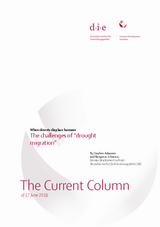The Current Column
When deserts displace humans
The challenges of “drought migration”
Adaawen, Stephen / Benjamin SchravenThe Current Column (2019)
Bonn: German Development Institute / Deutsches Institut für Entwicklungspolitik (DIE), (The Current Column of 17 June 2019)
Bonn, 17 June 2019. This week will see the United Nations mark in close succession “World Day to Combat Desertification and Drought” (17 June) and “World Refugee Day” (20 June). And the proximity between the two days is not only temporal – there is much to suggest that desertification and migration are also closely linked at causal level. The United Nations predicts that some 60 million people in the drought regions of sub-Saharan Africa alone will be forced to move to North Africa or Europe in the coming decades as a result of the severe threat posed by desertification. Policy-makers and the media are also repeatedly pointing to a possible correlation between drought and the outbreak of armed conflict, which trigger new refugee movements. So, will droughts and advancing desertification send a new wave of refugees towards Europe? And what do researchers have to say about the correlation between drought, desertification and human mobility? How should policy-makers address this “drought migration”? It is estimated that there are approximately 2 billion individuals around the world living in arid zones, many of them in Africa. Now, it is certainly not as if this vast number of people faces the immediate threat of being swallowed up by the desert. The term “desertification” should not be equated with the spread or migration of existing deserts. Rather, it describes a process of (severe) land degradation, which may involve decreasing soil fertility, as well as soil salinisation or soil compaction. In addition to arid regions, it also affects other ecosystems such as savannahs. Desertification can be caused by climate phenomena, in particular frequent and prolonged periods of drought. However, in many cases, the causes are man-made, resulting, for instance, from the excessive use of non-organic fertiliser, overgrazing or slash-and-burn farming. These processes that promote desertification are usually complex and closely interlinked. The correlation between soil degradation/desertification and migration is equally complex. While the available data on human mobility in this and other contexts is rather patchy, numerous studies paint a reasonably clear picture. It is certainly not the case that crop failure and water scarcity resulting from soil degradation and persistent drought lead automatically to mass migration, especially not towards Europe. Instead, many affected families opt for circular migration, usually within their own country or in a neighbouring country. This means that individual family members migrate for a limited period of time in order to earn money in the informal sector in cities or in commercial agriculture. If they are successful – something which is not guaranteed considering the generally harsh living and working conditions for migrants – the money they earn can certainly make up for the damage they have incurred as a result of drought and degradation. Forced migration is especially widespread in regions characterised by political instability and violent conflict as well as a probability of droughts and desertification, such as the Horn of Africa. At the same time, many of those affected by soil degradation and drought are also consigned to living in a state of immobility as they either simply lack the resources required for migration or these resources are being robbed by ecological change. This affects poor, smallholder households and, more especially, pastoralists. Unfortunately, national governments and regional organisations in the affected world regions and even development cooperation actors often still take the oversimplified view that migration is one of the worst effects of desertification and environmental change as a whole. What is clear is that we need to firmly resolve to support people in vulnerable contexts so that they do not have to flee in the first place. Nonetheless, political actors should recognise that certain forms of migration can also have positive effects in this context (for example via cash transfers), helping people to better adapt to the consequences of environmental change. If these positive effects are to be encouraged politically and negative ones mitigated, then better data on human mobility in environmentally vulnerable contexts are urgently required. There is also a need for dialogue between all relevant policy and action areas of international cooperation, from migration and humanitarian assistance to agriculture and rural development. The goal must be to achieve a common and differentiated understanding of the challenges of “drought migration”. While this is certainly not a solution, it is at least a start.
Stephen Adaawen is Consultant a United Nations Framework Convevtion to Combat Desertification (UNCCD and Associate Researcher of the Research Programme "Environmental Governance and Transformation to Sustainability" at the German Development Institute / Deutsches Institut für Entwicklungspolitik (DIE).
Benjamin Schraven is Senior Researcher at the Research Programme "Environmental Governance and Transformation to Sustainability" at the German Development Institute / Deutsches Institut für Entwicklungspolitik (DIE).


